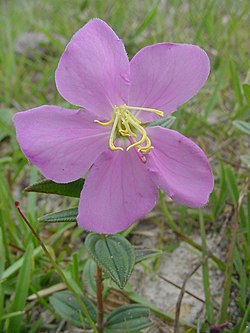| Pleroma asperius | |
|---|---|
 | |
| In Mostardas, Brazil | |
| Scientific classification | |
| Kingdom: | Plantae |
| Clade: | Tracheophytes |
| Clade: | Angiosperms |
| Clade: | Eudicots |
| Clade: | Rosids |
| Order: | Myrtales |
| Family: | Melastomataceae |
| Genus: | Pleroma |
| Species: | P. asperius |
| Binomial name | |
| Pleroma asperius | |
| Synonyms [1] | |
| |
Pleroma asperius is a species of flowering plant in the family Melastomataceae, native to Brazil. [1] It was first described by Adelbert von Chamisso in 1834 as Lasiandra asperior. [2] One of its synonyms is Tibouchina asperior. [1]